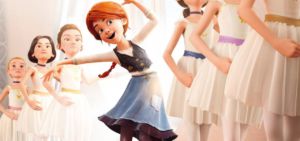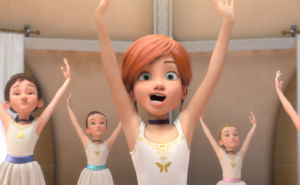Jumping past the main plot of the story, the newly released animated film “Leap” contains mostly unnecessary fluffiness and unrealistic features. Based on an orphan and her best friend’s journey in Europe in the late 1880s, the movie did a subpar job of captivating the audience and effectively delivering the storyline.
Starting off with minimal background on the main characters, Felicie and Victor, the film progresses quickly, showing how eventually the two are able to escape their orphanage in France and successfully follow their individual dreams in Paris.
The film portrays the two as extremely cheerful, despite being eager to leave the strict orphanage in which they live. Immediately, Felicie and Victor escape and end up in Paris with no plan and no directions. The two friends get split up and, with no real structure, the story follows Felicie’s journey to becoming a ballerina. As the story continues, Felicie impersonates another ballerina to get accepted into an esteemed class, although she has never danced ballet before. Meanwhile, Victor is working on his goal of becoming an inventor, and hints about working on a big project.
Throughout the entire film, pointless details were added that were confusing and took away from the bigger picture. For example, when Felicie and Victor first arrive in Paris, Victor falls onto a boat and gets lost. Felicie leaves as if nothing happened and eventually Victor shows up again, completely unfazed by the incident. This random scene does a poor job of engaging the viewer and throws the movie off track.
Although the plot contains an excessive amount of fluff, it had a couple of fairly interesting scenes. As Victor, pursues his dream of becoming an inventor, he meets another boy with the same ambition. After collaborating for a few days, they become partners and work together on a secret project to build the Statue of Liberty. Similarly, Felicie follows her passion, enduring extensive training with her new-found mentor, Odette, to compete with the other students in the class and attain the only open position in the upcoming Nutcracker performance. These two scenes are both compelling and well-written, providing inspiration and showing how much determination they have to accomplish their goals.
The soundtrack of the movie was a bit unexpected for being based in the late 1800s, as it used current hit songs in the background for some of the more classical ballet dances. This was an interesting touch to the film and gave it a more upbeat vibe, making it more relatable to its younger viewers with commonly known songs.
Without much background and minimal foreshadowing, an antagonist is introduced and immediately takes on a huge role in the story—the mother of a competing ballerina becomes infuriated over her child not getting the lead role and tries to injure Felicie so she cannot perform. However, this unnecessary plot twist overwhelms and distracts from the main idea of the story.
As “Leap” progresses, it hints at a few important underlying messages: how far are you willing to push yourself to reach a goal? How can different situations affect your individual virtues? Despite the various failures of the film, it skillfully answers these questions through a series of steps taken by Felicie during her journey.
Overall, “Leap” struggles to provide certain details for confusing scenes that would help make the movie engaging and more interactive with the audience. Although the the film includes some interesting character developments, its poor construction outweighed the few positive qualities.









